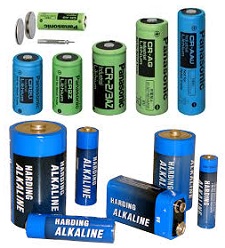Passive Components Products:
Primary Batteries
Primary Non-Rechargeable Batteries
 Primary non-rechargeable batteries, also known as disposable batteries, are designed for single-use applications. Once their chemical energy is depleted, they cannot be recharged and must be disposed of properly. Here are some common types:
Primary non-rechargeable batteries, also known as disposable batteries, are designed for single-use applications. Once their chemical energy is depleted, they cannot be recharged and must be disposed of properly. Here are some common types:
1. Alkaline Batteries:
- Composition: Alkaline batteries use manganese dioxide as the positive electrode and zinc powder as the negative electrode, with an alkaline electrolyte.
- Applications: Widely used in everyday devices such as remote controls, toys, flashlights, and clocks.
- Advantages: Relatively inexpensive, widely available, and have a long shelf life when not in use.
- Disadvantages: Limited capacity compared to other types, not suitable for high-drain devices.
2. Lithium Batteries:
- Composition: Lithium batteries use lithium as the active material in the anode and cathode.
- Types: Includes lithium metal (non-rechargeable) and lithium-ion (rechargeable) batteries.
- Applications: Common in devices requiring high energy density, such as cameras, watches, medical devices, and some electronics.
- Advantages: High energy density, long shelf life, lightweight.
- Disadvantages: More expensive, can be hazardous if improperly handled or disposed of.
3. Zinc-Carbon Batteries:
- Composition: Zinc-carbon batteries have a zinc anode, manganese dioxide cathode, and ammonium chloride electrolyte.
- Applications: Used in low-drain devices like clocks, flashlights, and remote controls.
- Advantages: Inexpensive, widely available.
- Disadvantages: Low capacity, shorter shelf life compared to alkaline batteries.
4. Silver Oxide Batteries:
- Composition: Silver oxide batteries use silver oxide as the positive electrode and zinc as the negative electrode.
- Applications: Commonly used in small electronics like watches, calculators, and hearing aids.
- Advantages: High energy density, stable voltage.
- Disadvantages: Higher cost, limited capacity compared to lithium batteries.
Rechargeable Batteries
Rechargeable batteries are designed to be recharged and reused multiple times, making them more environmentally friendly and cost-effective in the long run. Here are some common types:
1. Nickel-Metal Hydride (NiMH) Batteries:
- Composition: NiMH batteries use nickel oxide hydroxide as the positive electrode, a hydrogen-absorbing alloy as the negative electrode, and an alkaline electrolyte.
- Applications: Used in devices like cameras, toys, cordless phones, and power tools.
- Advantages: Higher capacity than NiCd batteries, less prone to memory effect.
- Disadvantages: Lower energy density than lithium-ion batteries, self-discharge over time.
2. Lithium-Ion (Li-ion) Batteries:
- Composition: Li-ion batteries use lithium ions moving between the anode and cathode.
- Applications: Common in smartphones, laptops, tablets, electric vehicles (EVs), and many other portable electronics.
- Advantages: High energy density, lightweight, less self-discharge.
- Disadvantages: More expensive to manufacture, sensitive to high temperatures, potential safety risks if damaged.
3. Nickel-Cadmium (NiCd) Batteries:
- Composition: NiCd batteries use nickel oxide hydroxide as the positive electrode and cadmium as the negative electrode.
- Applications: Historically used in power tools, toys, and portable electronics.
- Advantages: Good cycle life, can handle high discharge rates.
- Disadvantages: Heavy metal content (cadmium is toxic), memory effect if not properly maintained, lower capacity compared to NiMH.
4. Lead-Acid Batteries:
- Composition: Lead-acid batteries use lead dioxide as the positive electrode, metallic lead as the negative electrode, and sulfuric acid as the electrolyte.
- Applications: Used in vehicles (cars, motorcycles), uninterruptible power supplies (UPS), and backup power systems.
- Advantages: Low cost, good energy density, well-established technology.
- Disadvantages: Heavy and bulky, requires maintenance (topping up electrolyte), can be damaged by deep discharges.
Comparison:
-
Capacity: Rechargeable batteries typically have higher capacity and can be recharged hundreds to thousands of times.
-
Cost: Initially more expensive, rechargeable batteries are cost-effective in the long term due to their reusability.
-
Environmental Impact: Rechargeable batteries are more environmentally friendly as they reduce waste, but they do require energy to recharge.
-
Convenience: Non-rechargeable batteries are convenient for single-use applications, while rechargeable batteries require charging but are versatile for multiple uses.